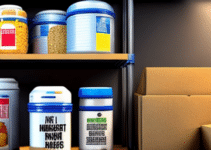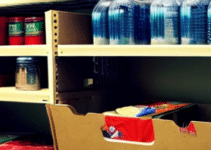In times of crisis or natural disasters, it is crucial to prioritize emergency preparedness for survival by ensuring you have a well-stocked emergency kit and ample survival supplies. It is essential to have a well-stocked supply of survival food and water storage.
When selecting emergency provisions, it is important to choose foods that have a long shelf life and require minimal preparation.
Examples of such foods include canned goods, dried fruits, and freeze-dried meals.
It is recommended to store at least one gallon of water per person per day, using food-grade containers. It is necessary to regularly check and rotate emergency supplies to ensure freshness. Investing in water purification methods can guarantee a continuous supply of emergency provisions.
Click here to learn more about: ‘ patriot
Importance of Emergency Storage
In addition to having a well-stocked survival kit and ample supplies of emergency food storage and emergency water storage, it is important to consider long-term food storage options for extended periods of crisis, such as creating an emergency pantry or building a long-term food stockpile. Long-term food storage involves storing non-perishable items that can last for years, providing a reliable source of sustenance during prolonged emergencies.
This can include items such as dehydrated or freeze-dried meals, as well as bulk grains, beans, and other staples that have a long shelf life.
Similarly, long-term water storage involves establishing a system for storing and purifying water for an extended period, ensuring a safe and reliable supply of drinking water. By incorporating long-term storage of emergency food and water supplies, you can ensure the readiness of your survival kit and maintain a well-stocked emergency pantry.
Essential Items for Emergency Storage
When it comes to emergency storage, it's important to have more than just a well-stocked pantry and ample supplies of water; you need a comprehensive emergency preparedness kit with essential supplies for survival. In addition to emergency food storage and water storage, there are other essential items that should be included in your emergency preparedness kit to ensure you and your family's safety during challenging times.
One key item to consider is a reliable source of light and communication.
This can include batteries, flashlights, and a portable radio.
These items are crucial in case of power outages or when staying informed is necessary.
It is essential to think about the specific needs of your family members, including infants or pets. In an emergency situation, stocking up on formula is crucial for your emergency preparedness supplies.
| Essential Items | Emergency Food Storage | Water Storage | Light and Communication |
|---|---|---|---|
| Batteries | Flashlights | Portable radio | Power outages |
| Formula |
Proper Storage of Emergency Food and Water
It is essential to store your emergency food and water supplies in a cool, dark, and dry location to ensure their longevity during a disaster. Extreme temperatures and exposure to sunlight can accelerate the degradation of both food and water, reducing their shelf life.
Ensure that your storage area is free from any potential contaminants such as chemicals or cleaning agents.
It is also advisable to label your containers with the date of storage and the contents inside.
This will help you keep track of the expiration dates and easily identify the specific food or water you need during an emergency. Consider having a sufficient amount of emergency food and water for each member of your household.
The recommended amount is typically a three-day supply, but it is advisable to have a two-week
Best Containers for Emergency Storage
When it comes to storing emergency food and water essentials, selecting the appropriate food and water storage containers is crucial for ensuring their safety and longevity. One option for food and water storage is using heavy-duty plastic containers with secure lids.
These containers are durable and airtight, protecting your supplies from moisture and potential damage.
They are also easy to transport and stackable, allowing for efficient use of space.
Another option is to use food-grade buckets with airtight lids, which are specifically designed for long-term food storage. These buckets are made from materials that won't contaminate the food and have sealing mechanisms to keep out air and moisture. Large water containers or barrels are ideal for storing water, which is essential in any emergency food and water kit.
| Food and Water Storage Containers | Features |
|---|---|
| Heavy-Duty Plastic Containers | Durable and airtight |
| Food-Grade Buckets | Specifically designed for long-term food storage |
| Large Water Containers or Barrels | Ideal for storing water |
LongTerm Solutions for Food and Water Storage
When planning for emergency preparedness and the need for long-term food and water storage, it is important to have a reliable system in place that incorporates effective food and water storage methods. A key aspect of this system involves selecting the right containers for storage.
It is recommended to choose containers that are airtight, durable, and capable of withstanding varying temperatures.
These containers should also be able to protect the stored food from pests and moisture.
Mason jars, mylar bags, and food-grade buckets with tight-fitting lids are all excellent options for storing dry goods such as grains, beans, and pasta. Investing in a vacuum sealer can help extend the shelf life of perishable items like meat and vegetables.
Another crucial consideration when it comes to long-term food storage is selecting the most suitable food items
Tips and Guidelines for Emergency Storage
When it comes to emergency storage, one key aspect that should not be overlooked is the organization and management of food and water storage supplies, including nonperishable food storage and water purification. Properly organizing and managing your storage can make all the difference in times of crisis.
By implementing effective systems and strategies, you can ensure that your supplies are easily accessible, well-preserved, and safe for consumption.
To maximize the efficiency and safety of your emergency storage, there are various steps you can take.
One important step is labeling and categorizing your supplies. This will allow you to easily find what you need when it matters most.
Another step is rotating stock, meaning you should use the oldest items first and replace them with new ones. This ensures that your supplies stay fresh and safe for both food and water storage.
| Aspect | Importance |
|---|---|
| Labeling and Categorizing | Allows easy access and retrieval of supplies |
| Rotating Stock | Ensures freshness and safety of supplies |
Planning and Organizing Storage
When it comes to planning and organizing storage, it is crucial to consider multiple factors, such as water storage solutions, that can optimize space utilization and accessibility. One important aspect to address is the selection of appropriate storage solutions based on your specific needs.
Whether it be shelves, cabinets, or bins, choosing the right storage options can effectively accommodate your belongings.
Maximizing the available space is key, and utilizing vertical storage options such as tall shelves or overhead racks can make a significant difference.
It is also important to ensure that the flow and accessibility of the storage area are well-thought-out, with frequently used items easily accessible and items that are used less frequently stored in less accessible areas.
Labeling and categorizing items further streamline the storage system, allowing for quick and easy retrieval. Regular water treatment methods are essential for maintaining clean and safe drinking water.
Ensuring Safety in Storage
One key aspect of ensuring safety in storage is to carefully consider the choice of water storage guidelines. It is essential to opt for water storage methods and water storage recommendations for long-term storage.
These containers protect the stored items from external elements while ensuring their safety and quality.
Labeling the containers with the date of storage can help keep track of the shelf life of the items, preventing the consumption of expired or spoiled food in emergency situations.
Taking these precautions can make a significant difference in the effectiveness of your water storage options, water storage ideas, water storage strategies, water storage preparations, and water storage planning
Water Storage
- Proper water storage methods and recommendations are crucial for long-term storage to ensure the safety and quality of the stored items.
- Labeling the containers with the date of storage helps in tracking the shelf life of the items, preventing the consumption of expired or spoiled food during emergency situations.
- Taking precautions in water storage options, ideas, strategies, preparations, and planning can significantly enhance the effectiveness of the storage process.
Purification and Treatment of Water for Storage
When organizing and managing a water storage organization, it is important to prioritize purification and treatment to ensure water storage safety. These steps are crucial to keeping the water safe for consumption.
In emergency situations, having a reliable water supply is essential.
Therefore, treating the water before storage is vital in order to prevent the growth of harmful microorganisms.
Filtration is an effective method for removing physical impurities. It helps to eliminate any debris or particles that may be present in the water.
Disinfection is another key step in water treatment. It involves killing or inactivating microorganisms that may be present in the water.
This helps to prevent the spread of bacteria and viruses. Chemical treatment can also be used as an additional measure to disinfect the water stored, ensuring water storage safety for the organization.
NonPerishable Foods for Storage
When it comes to preparing for emergencies or ensuring long-term food storage, nonperishable foods are essential provisions. These items have a longer shelf life and do not require refrigeration, making them ideal for stockpiling.
Having a supply of nonperishable foods is crucial for preparedness and survival in disaster situations.
One important factor to consider when choosing nonperishable foods is their nutritional value.
It is advisable to opt for options that are high in protein, fiber, and essential vitamins and minerals to ensure a well-balanced diet during challenging times. Versatility is key when selecting nonperishable items for disaster preparedness.
Facts Supporting the Importance of Nonperishable Foods for Emergency Preparedness
- Nonperishable foods have a longer shelf life, allowing for extended storage without spoilage.
- These foods do not require refrigeration, making them suitable for stockpiling in emergency situations where electricity may be unavailable.
- Choosing nonperishable foods high in protein, fiber, and essential vitamins and minerals ensures a well-balanced diet during challenging times.
- Versatility is crucial when selecting nonperishable items for disaster preparedness, as they can be used in various meal preparations and situations.
Essential Gear for Storage
When it comes to storing essential gear for emergencies, long-term solutions and containers for stockpiling essentials should not be overlooked.
One important piece of gear is a durable and waterproof storage container.
These containers or buckets can help protect your emergency supplies from moisture and pests, ensuring their longevity.
Another essential item to consider is a portable stove or cooking system.
This allows you to prepare meals even during power outages or when access to a kitchen is limited.
Investing in high-quality sleeping bags and camping gear is also crucial.
They provide comfort and protection during times when shelter is scarce.
Having a reliable communication device such as a two-way radio or a satellite phone can keep you connected to the outside world when traditional means of communication are down
Emergency Food and Water Affordable and Essential
Survival Food Stock Up on Essential Supplies





